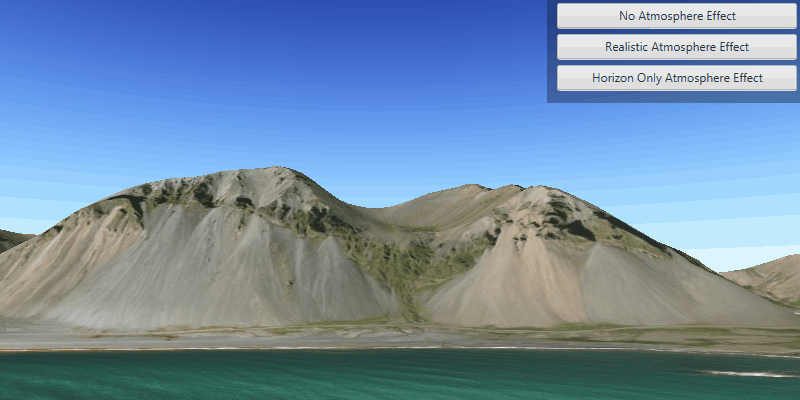Changes the appearance of the atmosphere in a scene.

Use case
Atmospheric effects can be used to make the scene view look more realistic.
How to use the sample
Select one of the three available atmosphere effects. The sky will change to display the selected atmosphere effect.
How it works
- Create an
ArcGISSceneand display it in aSceneView. - Change the atmosphere effect with
sceneView.setAtmosphereEffect(atmosphereEffect).
Relevant API
- ArcGISScene
- AtmosphereEffect
- SceneView
Additional information
There are three atmosphere effect options:
- Realistic - A realistic atmosphere effect is applied over the entire surface.
- Horizon only - The atmosphere effect is applied to the sky (horizon) only.
- None - No atmosphere effect. The sky is rendered black with a starfield consisting of randomly placed white dots.
Tags
atmosphere, horizon, sky
Sample Code
ChangeAtmosphereEffectSample.java
/*
* Copyright 2018 Esri.
*
* Licensed under the Apache License, Version 2.0 (the "License"); you may not
* use this file except in compliance with the License. You may obtain a copy of
* the License at
*
* http://www.apache.org/licenses/LICENSE-2.0
*
* Unless required by applicable law or agreed to in writing, software
* distributed under the License is distributed on an "AS IS" BASIS, WITHOUT
* WARRANTIES OR CONDITIONS OF ANY KIND, either express or implied. See the
* License for the specific language governing permissions and limitations under
* the License.
*/
package com.esri.samples.change_atmosphere_effect;
import javafx.application.Application;
import javafx.geometry.Insets;
import javafx.geometry.Pos;
import javafx.scene.Scene;
import javafx.scene.control.Button;
import javafx.scene.layout.Background;
import javafx.scene.layout.BackgroundFill;
import javafx.scene.layout.StackPane;
import javafx.scene.layout.VBox;
import javafx.scene.layout.CornerRadii;
import javafx.scene.paint.Paint;
import javafx.stage.Stage;
import com.esri.arcgisruntime.ArcGISRuntimeEnvironment;
import com.esri.arcgisruntime.mapping.ArcGISScene;
import com.esri.arcgisruntime.mapping.ArcGISTiledElevationSource;
import com.esri.arcgisruntime.mapping.BasemapStyle;
import com.esri.arcgisruntime.mapping.Surface;
import com.esri.arcgisruntime.mapping.view.AtmosphereEffect;
import com.esri.arcgisruntime.mapping.view.SceneView;
import com.esri.arcgisruntime.mapping.view.Camera;
public class ChangeAtmosphereEffectSample extends Application {
private SceneView sceneView;
@Override
public void start(Stage stage) {
try {
// create stack pane and JavaFX app scene
StackPane stackPane = new StackPane();
Scene fxScene = new Scene(stackPane);
fxScene.getStylesheets().add(getClass().getResource("/change_atmosphere_effect/style.css").toExternalForm());
// set title, size, and add JavaFX scene to stage
stage.setTitle("Change Atmosphere Effect Sample");
stage.setWidth(800);
stage.setHeight(700);
stage.setScene(fxScene);
stage.show();
// authentication with an API key or named user is required to access basemaps and other location services
String yourAPIKey = System.getProperty("apiKey");
ArcGISRuntimeEnvironment.setApiKey(yourAPIKey);
// create a scene with a basemap style
ArcGISScene scene = new ArcGISScene(BasemapStyle.ARCGIS_IMAGERY);
// set the scene to a scene view
sceneView = new SceneView();
sceneView.setArcGISScene(scene);
// add base surface for elevation data
Surface surface = new Surface();
ArcGISTiledElevationSource elevationSource = new ArcGISTiledElevationSource(
"https://elevation3d.arcgis.com/arcgis/rest/services/WorldElevation3D/Terrain3D/ImageServer");
surface.getElevationSources().add(elevationSource);
scene.setBaseSurface(surface);
// add a camera and initial camera position
Camera camera = new Camera(64.416919, -14.483728, 100, 318, 105, 0);
sceneView.setViewpointCamera(camera);
// create a control panel
VBox controlsVBox = new VBox(6);
controlsVBox.setBackground(new Background(new BackgroundFill(Paint.valueOf("rgba(0, 0, 0, 0.3)"),
CornerRadii.EMPTY, Insets.EMPTY)));
controlsVBox.setPadding(new Insets(10.0));
controlsVBox.setMaxSize(260, 110);
controlsVBox.getStyleClass().add("panel-region");
// create buttons to set each atmosphere effect
Button noAtmosphereButton = new Button("No Atmosphere Effect");
Button realisticAtmosphereButton = new Button ("Realistic Atmosphere Effect");
Button horizonAtmosphereButton = new Button ("Horizon Only Atmosphere Effect");
noAtmosphereButton.setMaxWidth(Double.MAX_VALUE);
realisticAtmosphereButton.setMaxWidth(Double.MAX_VALUE);
horizonAtmosphereButton.setMaxWidth(Double.MAX_VALUE);
noAtmosphereButton.setOnAction(event -> sceneView.setAtmosphereEffect(AtmosphereEffect.NONE));
realisticAtmosphereButton.setOnAction(event -> sceneView.setAtmosphereEffect(AtmosphereEffect.REALISTIC));
horizonAtmosphereButton.setOnAction(event -> sceneView.setAtmosphereEffect(AtmosphereEffect.HORIZON_ONLY));
// add buttons to the control panel
controlsVBox.getChildren().addAll(noAtmosphereButton, realisticAtmosphereButton, horizonAtmosphereButton);
// add scene view and control panel to the stack pane
stackPane.getChildren().addAll(sceneView, controlsVBox);
StackPane.setAlignment(controlsVBox, Pos.TOP_RIGHT);
StackPane.setMargin(controlsVBox, new Insets(10, 0, 0, 10));
} catch (Exception e) {
// on any error, display the stack trace.
e.printStackTrace();
}
}
/**
* Stops and releases all resources used in application.
*/
@Override
public void stop() {
// release resources when the application closes
if (sceneView != null) {
sceneView.dispose();
}
}
/**
* Opens and runs application.
*
* @param args arguments passed to this application
*/
public static void main(String[] args) {
Application.launch(args);
}
}